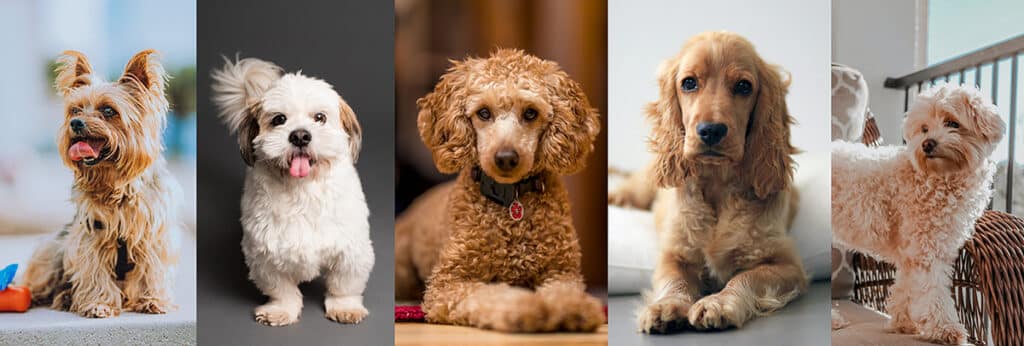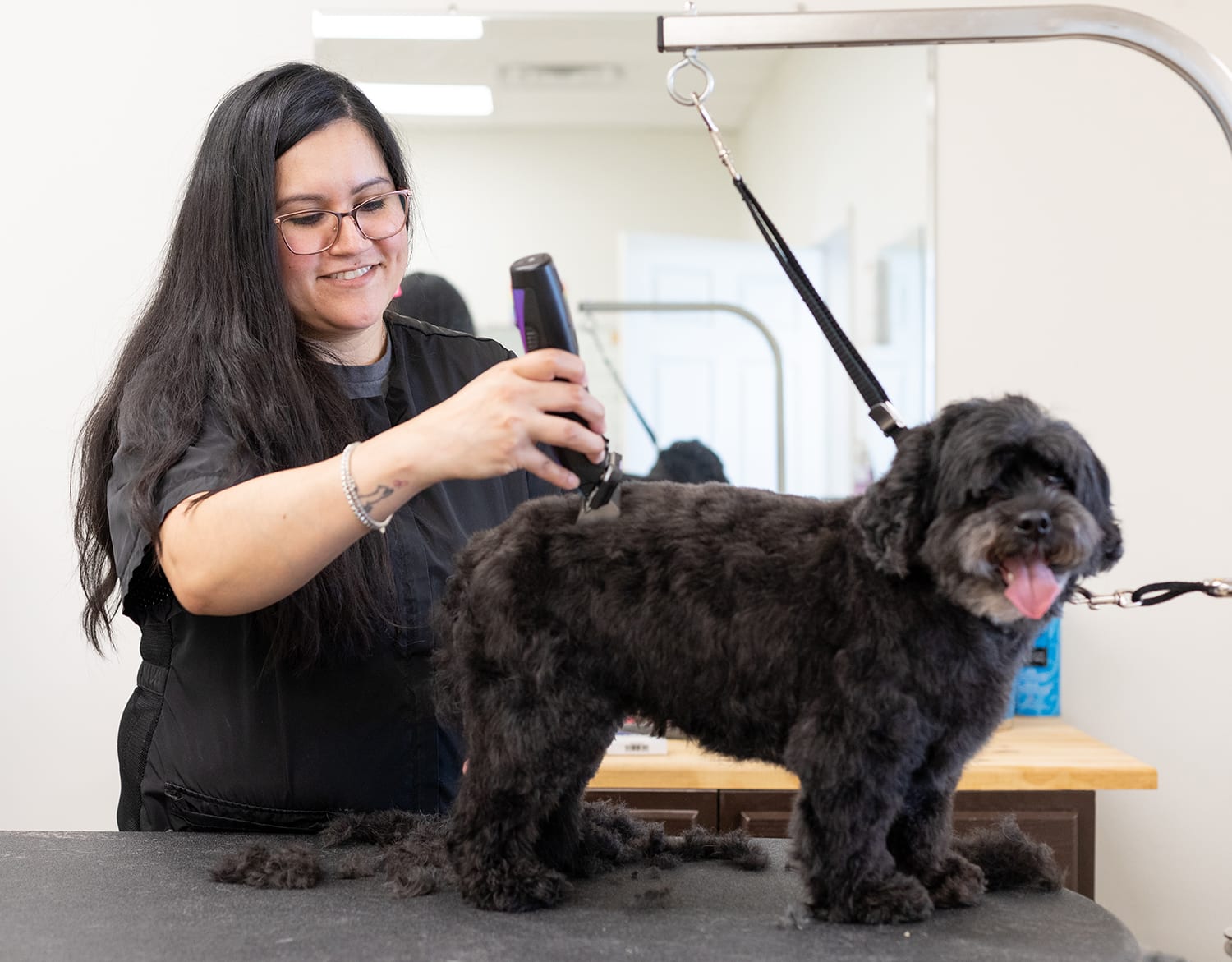One of the most common questions we hear in the grooming salon is: “How often should I get my dog groomed?”
Every dog should have their nails trimmed about every 4 weeks.
Most professional dog grooming appointments should be scheduled every 4-6 weeks, though some breeds may be able to go 6-8 weeks between grooms. Dogs with short coats, long coats and double-coats all have different needs, which affects how frequently we recommend they come in for grooming (more on that below).
Consistent professional grooming is equally important for all dogs, and your groomer is essential in keeping an eye on the health of your pet. Your pets typically see a veterinarian only once or twice a year, whereas your groomer should see your pet at least six times a year. Groomers check every aspect of your pet, and if you are consistent with the same groomer, they can help catch any new lumps and bumps or other potential health issues early on and help get you on the right path to resolve any concerns.
Grooming Dogs with Double Coats
Examples of Double-Coated Breeds:
- Australian shepherd
- golden retriever
- corgi
- Great Pyrenees
- border collie
- collie
- Shetland sheepdog
- Newfoundland
- Bernese mountain dog

Double-coated dogs should be groomed a minimum of every 4-6 weeks. These dogs are known as the “shedding dogs”, and that shedding can be kept at a minimum with a consistent grooming routine. You can maximize results by brushing at home in between grooming appointments.
Many wrongfully assume double-coated dogs have tough skin. In reality, they have a thick coat as the first line of defense and very sensitive skin. These dogs, if not groomed regularly, can develop major skin problems. Matting of the coat contributes further to these skin issues. While we have products and treatments that can help treat these skin issues, it is much easier to maintain healthy skin and coat than to fix damaged skin and coat.
Double-coated breeds have a dense, soft undercoat and a longer, more coarse outer coat or guard hairs. The dense undercoat helps protect the dogs from parasites and keeps it warm in the winter but also keeps it cool in the summer by trapping cool air and circulating it. The outer coat protects from sun damage, wind, weather, dirt and debris.
Dogs “blow” their undercoat in the warmer seasons. It’s especially important to professionally groom your pet during this time to ensure the undercoat is released instead of caught by the guard hairs, creating matting. If your dog develops mats, take them to a groomer to have them removed. Don’t try to cut mats out yourself, as they are often very close to the skin and you may accidentally injure your dog.
You may be tempted to shave your double-coated dog to prevent shedding or help keep them cool in the summer. Believe it or not, shaving actually puts these dogs at a higher risk for heatstroke! What remains of the undercoat after a seasonal coat blow helps to hold cool air close to the skin, and the double layers protect against sunburn.
Grooming Dogs with Long Coats
Examples of Long-Coated Dogs:
- shih tzu
- maltese
- havanese
- Yorkshire terrier
- doodle
- poodle
- cocker spaniel

There are many breeds that could fit into this category, but for our purposes, we will discuss breeds such as maltese, shih tzu’s, poodles and doodles as a few examples. Long-coated dogs have much more demanding needs when it comes to grooming. Unlike the previous coat types we discussed, these dogs can be shaved, or given an all-over haircut.
This category can consist of single, silky coats, wire coats, and curly coats, and the grooming frequency required depends on your haircut preferences. If you like your pet’s hair short, you may be able to go 4-6 weeks in between professional grooming appointments. If you like your pet’s hair long and fluffy, you may need to see a dog groomer every 2-4 weeks. This is because longer coats require more frequent bathing to prevent matting (as well as consistent brushing between grooming appointments).
The long coat types grow continuously and need to be trimmed periodically to maintain good health of the skin and coat. Matting or tangling of the coat can have multiple causes. Your pet’s coat may mat due to a coat change (puppies lose their soft, fluffy puppy coat and it gets caught in the new adult coat), pets wearing items (clothes, harnesses or collars), petting your dog consistently in the same location, and rolling around on the floor, furniture or outside.
Most matting is caused first by static electricity tangling the hair, and the problem intensifies when your pet isn’t brushed. We recommend investing in a nice wire slicker brush and metal comb to help stay on top of matting. Remember: if you notice mats in your pet, take them to a professional pet groomer to get it resolved. Mats can be intertwined around the skin, and pulling them away from the skin can be nearly impossible. It is very likely that you will unintentionally cut your dog if you try to cut out a mat. It is much safer to let a professional groomer remove any mats your pet may have.
Grooming Dogs with Short Hair
Examples of Short-Haired Breeds:
- pug
- pit bull
- lab
- chihuahua
- beagle
- Boston terrier
- whippet

Short-coated dogs can go longer in between grooming appointments than double- or long-coated breeds, though consistency is still key. Typically, 6-8 weeks is a good frequency for dogs with short coats, though they can be groomed every week. If your pet begins to stink, it’s usually a good sign it’s time to make an appointment!
Short-coated dogs have a disadvantage that other dogs do not have. All dogs have natural oils and minerals on their skin that are produced by their endocrine system. Because their hair is short, it is easy for them to rub those oils off on carpet, furniture and any other environmental surfaces they come in contact with. This layer of oils and minerals acts as a barrier on their skin to keep toxins out. If it is all removed, your pet may develop skin issues and become more prone to environmental allergy issues.
Professional groomers should be using products that assist with repairing that protective coating. If your pet is shedding excessively, ask your groomer if there are particular products or a deshedding treatment that could help. Pets that are consistently groomed should not shed excessively. If they do, this could be an indication of an internal issue, such as nutrition.
It’s important to note that all dogs shed – yes, even short-haired dogs and shaved dogs.



